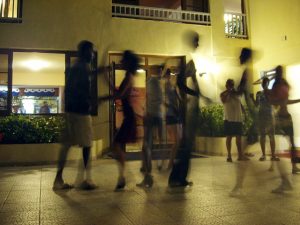It is an absolutely beautiful morning this morning here as I write this. So after breakfast I decided I would take a stroll around where I live. The photograph above was taken at the end of my walk because I wanted to capture the beauty of the morning.
It was extremely warm. There was only a very slight breeze. It was gorgeous.
I wandered up the quiet avenues taking in the morning air. Good natured and hearty morning greetings and a comment on how great the weather was were shared. This was with the various dog walkers and old folk out strolling that I met along the way.
In fact it was how I imagine it to be like in Spain. I love the weather when it is like that.
But back to learning Spanish.
Combine Your Daily Review With A Good Walk
There is no doubt that it takes time and this morning I found another way of fitting at least part of my daily review in.
I combined it with my walk.
So with earphones in, Anki opened up on the iPhone I strode forward into the gorgeousness of the morning.
A quick look down at the current Anki flashcard to see what it was challenging me to remember and then head up whilst I attempted the recall.
All of course whilst still walking.
Another quick glance at the phone to check to see if I was right or not, thumb on the green button for yes and red button for no and then it is the next card.
And then rinse and repeat.
With the words I knew really well I might be calling up a new card every 4 or 5 paces (I walk quite quickly). Sometimes when I pondered a bit on the word I might take 10-20 paces before calling up the next card.
The most steps came that between cards usually occurred when it was a new word and I was trying to create mnemonic imagery to help remember it.
This morning new words like el almuerzo and la mesara were at least 50 step words.
“But what about safety Michael?”I hear you ask.
Well that is a great question (and I am somewhat impressed by its challenging tone!).
My answer to that is this:
- I am only glancing down at the phone briefly before looking up again.
- By looking ahead as I walk I can anticipate when it is probably not a good idea to be looking down at my phone
- The roads where I live are extremely quiet with hardly any traffic (I was passed by 2 vehicles over a 20 minute walk)
So let’s get this clear. I am not going to recommend you do this on your daily commute when battling through the crowds.
With a bit of thought you can find lots of opportunities like this to do a quick review of your cards.
The secret is little and often.
If you are committed to learning another language, there really is no excuse for you to find the time to do some flashcard reviews, even if it is just 5 minutes.
At least that is what I am telling myself.
Understanding Accents And Emphasis (or Stress)
I am sure you have realised by now that Spanish people will say similar words to ones we use in a completely different way.
They emphasise different syllables to us or even add an emphasis that we might not have.
Now I am not going to use this as an opportunity to preach about the rules of accent and emphasis.
They exist.
In fact if you have taken any sort of formal training, an early lesson might have explained why some letters have an accent over them (á, é, í, ó, ú).
You might have also seen rules like this:
If the word ends in a vowel, an -n, or an -s, the second to last syllable is stressed.
If the word ends in any consonant besides -n or -s, the last syllable is stressed
Of course those are absolutely correct.
By the way, the reason for the á, é, í, ó, ú, is to show when the the above two rules are broken.
“YOU MEAN THERE I RULES I HAVE TO LEARN AND THEN THEY GET BROKEN TOO!!!!!!!”
Big breaths… big breaths….
The problem is…
These rules don’t help at the start of your learn Spanish journey.
Don’t Learn The Rules – Discover Them
Rules confusing at the beginning stage.
I wasn’t even aware of the stress in words and when I first began learning Spanish just a few weeks ago, I struggled to recognise when and where they occurred.
Intellectually I understood the rules, but I couldn’t make sense of them with what I knew at the time.
However fear not.
Your understanding of it will come.
It will come gradually as you are exposed to the language.
I had an experience of that this morning.
I was reviewing the word for eagle which is el águila (it’s actually a feminine word but more of that another time!!!).
Taken phonetically the word has these syllables:
AGG – EE – LAH
Now let’s play with this.
According to the rules (If the word ends in a vowel, an -n, or an -s, the second to last syllable is stressed), the emphasis (or stress) should be on the EE part.
AGG – EE – LAH
Try saying the word with that emphasis. It would be different to saying it with this emphasis:
AGG – EE – LAH
But….
This word breaks the rules because the stress is on the first syllable like this:
AGG – EE – LAH
And because it breaks the rules, the accent is placed over the á.
águila
I have just taken some time to explain what I now know. For you reading this (assuming you have yet to make this distinction yourself) it is probably still just an intellectual exercise.
For this lesson to be really powerful and for it to stick, you have to make the realisation yourself and discover how accents and emphasis work.
No amount of reading or understanding of the theory can take the place of you following your curiosity, exploring and then discovering.
When you get these insights, you will think you have found gold in them there hills and will want to tell everyone about it.
Because this discovery feels fantastic because of all the great brain chemical shit going on when this happens.
The development of our Spanish will take place one micro step at a time with many lessons that unfold as we step forward.
That is true learning.
I’m Anticipating A Problem
 I have decided to really embrace the Spanish theme. And to do that I have started learning to dance salsa.
I have decided to really embrace the Spanish theme. And to do that I have started learning to dance salsa.
It has been a long time goal of mine and is in fact on my bucket list of things to do. Though the actual bucket list entry is about learning salsa in Cuba. But let’s not split hairs.
I have always enjoyed music with a latin theme and can remember the thrill of discovering Carlos Santana.
And so it was an easy decision to take to start learning to dance salsa.
I also figured that if I am going to be travelling to Spanish speaking countries, then if I can dance salsa, I have a fun way of meeting and interacting with locals.
So I did my first class last week and my second class two nights ago.
It was a lot of fun and of course I went straight into the beginners enclosure.
We were taught the basic count, a forward step, a backward step, a mamba step and a rumba side step. Over the lesson we even evolved into having the ladies do a turn and then I got to do one as well.
In the safety of the beginners enclosure all this seemed very straightforward.
We got to chance partners regularly so we could try out our moves with different people.
It was so much fun.
And I actually felt I was making progress.
A quick glance at the other blokes in the class and I felt a little bit smug that I seemed to be less wooden and making less mistakes than them.
In fact, I was even somewhat proud of the little hip shimmy I was throwing in occasionally (must be all that yoga!).
And so after the class it was onto the dance floor with the intermediates and the advanced dancers for an hour of free form dancing. Apparently you just keep changing partners with every change of dance track until the evening ends.
Mmmmmm….
So I have to dance with others eh?
I began to sneak off but got collared by a delightful lady whose toes I had been squashing in the beginners class. It was the first time I had ever been asked to dance by someone of the opposite sex!
I am used to the dynamic being the other way round and with a much lower success rate!
Anyway, we got on to the dance floor and stumbled our way through the most basic of the basic moves we had been taught.
Well when I say “we stumbled” I mean “I stumbled”. My dance partner was most gracious and very understanding and we laughed our way through the track. Meanwhile others were twirling and whirling around us doing some magnificent and truly graceful moves using the whole dance floor.
I think we shuffled together in the same square metre of space making tentative progress forward and back and occasionally to the side over the three minutes we were paired up!
At the end of the dance I thanked, apologised, thanked and then apologised again.
As the protocol was to change partners at the end of every dance, I took the opportunity to sneak off under the pretence of going to get a drink.
There certainly wasn’t a queue of ladies waiting to sample my salsa skills so I managed to escape unchallenged!
So what is the problem I am anticipating?
Well undeterred, I went to a second salsa class 3 nights later. This time at a different venue.
Once again I got herded into the beginners enclosure with 7 others (this time in a separate room from the dancing ninjas).
The instructors were excellent and started with the basics again – the basic count, a forward step, a backward step, a mamba step and a rumba side step. They even added an open step and a forward open step.
Then we eventually worked up to the move of the evening which was the ballroom turn. Essentially a 360 degree swivel whilst holding your partner in a close hold. Not, as was pointed out to me, a headlock.
The move was broken down step by step and over the hour of the class we built it up. By the end of the lesson we were all twirling around in time to the music and with very few crushed toes.
All of a sudden the lesson was over and it was time for free form dance in the other room.
My delightful dance partner from my first lesson was also in the class and I made a beeline for her.
Again she was gracious in accepting my request to dance (at this point I am on a 100% “yes” response!).
And then I encountered the problem.
In the lesson, I was able to master the steps quite easily. The lady instructor even commented that I was doing really well for only my second lesson. I felt great and I even thought I looked good!!!
But…
In the 6 or 7 steps from the beginners room to the main dance floor, a number of things happened:
- I lost all sense of rhythm
- I lost the ability to count the beat
- My repertoire of moves shrank to a simple forward and back shuffle
The contrast couldn’t have been greater. In one room I felt like a (relatively) accomplished dancer. 30 seconds later when faced with the real world of the dance floor, I was a shuffling, stumbling idiot with no rhythm!
Of course I am just a beginner and I need to practice and eventually I will become better and all of this will be natural for me.
But it doesn’t necessarily make me feel good at this stage of learning.
Fortunately I understand what is going on and can deal with that.
How Does This Relate To Learning Spanish?
Well at the moment, in the comfort of my own home, I have developed a relative extensive working vocabulary in quite a short space of time.
I have become good at memorising words and installing them into my long term memory using the Anki Cards.
I have even started to explore grammar to begin to piece together some of my vocabulary into meaningful sentences.
Progress, it seems, is being made.
But my salsa experience has really made me realise that I am still in the practice room.
And if I really want to learn how to speak Spanish, I have got to get out there and speak Spanish.
…gulp!









Leave A Response